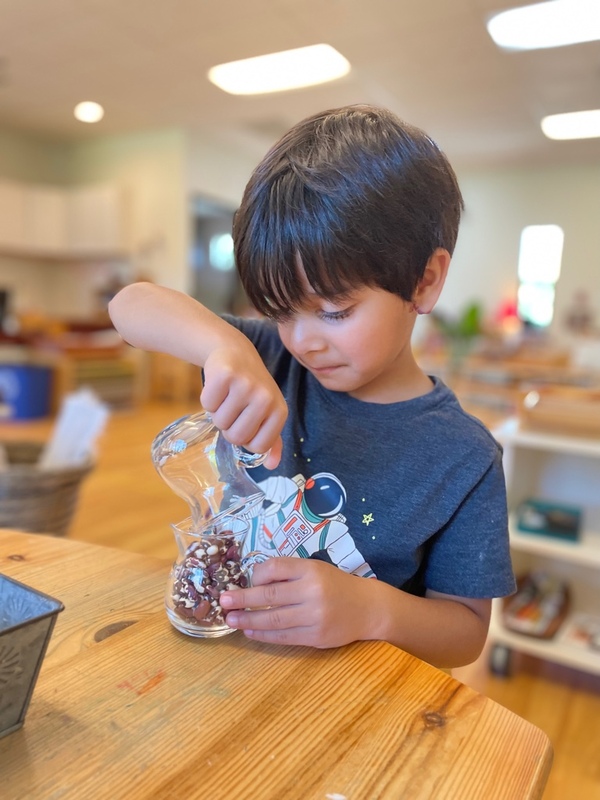(858) 759-0631
I want to talk about The Math Area in our classroom briefly. Like our Language program, the lessons in our Math area are presented to each child from concrete to abstract form. The child does this work within the three years of the primary program. The materials here are also set in progression, helping the child understand and accomplish the primary form of math.
Yet, before we dive entirely into our Math program, we must also discuss what Maria Montessori often spoke about: the Mathematical Mind. It is merely impossible to talk about Math without mentioning the Mathematical Mind. In fact, what is the Mathematical Mind? 'The Mathematical Mind is a power to organize, classify, and quantify within the context of our life experiences. This is a spontaneous activity of the mind. It is uniquely human and a capacity found in all human beings.'
The Mathematical Mind is part of the human mind, which is exact, orderly, and precise. It is present at birth and can be realized in the environment. Characteristically, it leads to operations and considering the environment from a certain point of view, which may be called mathematical. Man measures by nature, reasons by nature, and that reasoning and measuring are mathematical. Mathematics is the basis of all sciences. It is the most fascinating field of human activity. It is a particular expression that is only a characteristic of the human mind.
The child's first three years are full of concrete experiences, which indirectly prepares the mathematical mind when he notices the properties of everything around him. When the child comes to the children's house (a Montessori environment), he finds many more experiences that indirectly and directly prepare him for life. He observes experiments and abstracts finer and finer distinctions of volume, form, dimensions, colors, temperatures, and textures. He classifies and follows a sequential order that clarifies and organizes his mind, developing his mathematical concept.
That said, for this specific reason and ability, the child in a Montessori environment receives Math in a much larger sense than he would in a regular school setting. Many materials within the Practical Life Area and the Sensorial Area indirectly prepare the child for Mathematics.
Through the Practical Life Area, the child is prepared by:
- Following a logical sequence of steps
- Logical analysis of movements and actions
- Precise and orderly presentation
- Progression of difficulty
- Concentration
- Repetition and self-perfection
- Orderly work and finishing a cycle of activity
- Sequential material within a given presentation
- Refinement of movement necessary for handling the material
- Confidence in oneself and the material
- Control of error by verification of exactness
- Development of will
Through the Sensorial Area, the child is prepared by:
- Precise and definite perceptions through exactness of shapes and forms
- Exactness through precise presentations and use of materials
- Clarity of expression through appropriate language
- Provides clear impressions
- Materials themselves in the base of 10
- Orderliness
- Ability to carefully organize
- Materialized abstraction
- Development of Intelligence
- Control of Error
- Geometry: Pink Tower, Brown Stairs, Red Rods, Geometric Cabinets, Geometric Solids, Constructive Triangles, Graded Geometric Figures.
- Algebra: Bi- and Tri- nomial Cube, Decanomial Square
There are six main groups at the Primary level of our Mathematics program. These are as follows.
1) Numbers 1 - 10
2) Decimal System - Collective Exercises
3) Teens and Tens/ Counting
4) Exploration and Memorization of Tables
5) Passage to Abstraction
6) Fractions
Children under four years handle quantities below ten without any difficulty. The psychological difficulties for counting are first its meaning, which Segun solved with the Numerical Rods (Number Rods). Secondly, the method of dealing with the large numbers was solved by Maria Montessori with the material known as the 'Decimal System' material. Once these difficulties of numbers have been overcome, we open the child to the world of numbers for exploration. Then, the child enthusiastically proceeds as the number comes to man naturally and intuitively.
Each material in the classroom is brilliantly designed for the child to learn the concept of numbers in general and have a greater understanding of its foundation. Through concrete exploration and manipulation of these lessons, the child then receives a clear vision within his mind, which becomes the basis that helps support him when his work in Math gradually moves towards abstraction and memorization. From these experiences, the child once again not only gains a better understanding of Mathematics but also forms a love and interest in it.
Language and Mathematics are creations of the human mind. Its origin was even attributed to a superhuman being. Mathematics does not exist by itself. It is the expression of the human mind, and the expression and precision are artificial. The mind intelligence of humankind is perhaps the most excellent tool in the universe. We can explore and go to infinity. Laws run the whole universe; on the physical plane, many of those laws may be reduced to mathematical equations. The whole universe behaves according to mathematical principles. Mathematics's logic and reasoning help man discover his world and manipulate ideas around it. Even basic daily life activities use mathematics to streamline our dealings with the environment. Mathematics is in everything we do! Mathematics then requires some of the most profound thinking man does, yet he cannot go through a single day without using mathematics in some form, for its application is constant worldwide. Mathematics has grown with civilization. It came out of practical problems and how to help solve these problems. An understanding of mathematics is fundamental to working with one's environment, whether prehistoric, ultramodern, rich, poor, old, or young; mathematics is a part of a development aid.
-Bumblebee Teacher

